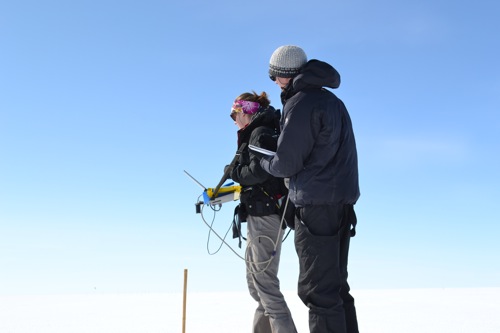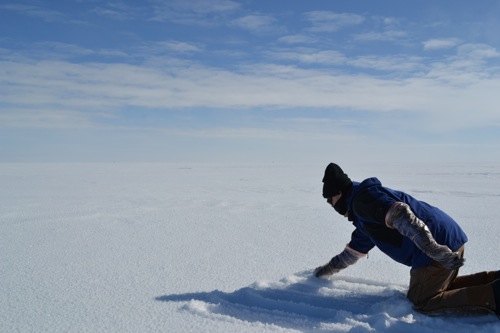Now that we are settled into camp, it is time to do some science! The purpose of this journal entry is to introduce you to our team and to explain what we are hoping to learn.
Our Team
First, our Summit team consists of myself, Brandon Strellis from Georgia Tech and Hannah James, a recent college graduate from St. Lawrence University. Of course, Mike Bergin is here with us in spirit. Mike and Brandon came to Summit camp for the month of May and we are continuing the work that they started.

Why are we on the Greenland ice sheet?
We are collecting data about aerosols. These are tiny particles that are floating in the air. These particles are so small that we can’t see them floating in the air. They range in size from a few nanometers to several tens of micrometers (which is about the diameter of a human hair).
90% of the aerosols are caused by nature. These natural sources of aerosols come from volcanic eruptions, forest fires, sea salt, and dust. The remaining 10% of the aerosols are human-made. They get into the air from the burning of fossil fuels or the burning of biomass. The black carbon and organic carbon that comes from the burning of fossil fuels and biomass is called “soot”.
AerosolsTiny solid particles or liquid droplets that remain suspended in the atmosphere for a long time. Aerosols are produced by natural processes or human activities, such as volcanic dust, sea spray, smoke from forest fires, particles emitted during the burning of fossil fuels, etc. come in many interesting shapes. You can see these shapes when you look at them under a scanning electron microscope. Go to http://earthobservatory.nasa.gov/Features/AerosolsTiny solid particles or liquid droplets that remain suspended in the atmosphere for a long time. Aerosols are produced by natural processes or human activities, such as volcanic dust, sea spray, smoke from forest fires, particles emitted during the burning of fossil fuels, etc./ to see some amazing close up photos of aerosols like pollen, soot, sea salt and volcanic ash.
Even though aerosols are small, they have a major affect on climate. Some aerosols reflect energy from the sun back into space. Other aerosols can absorb the energy from the sunlight. In other words, some particles can have a cooling effect on climate and other particles might have a warming effect on climate.
Our team is looking at the particles that are in the air and on the snow in order to determine if they may be affecting climate here in the Arctic.

Well, that is it for now. I need to get some sleep because we have a busy day ahead of us. You can find some definitions of the bolded words at the end of this journal.
Key Terms:
AerosolsTiny solid particles or liquid droplets that remain suspended in the atmosphere for a long time. Aerosols are produced by natural processes or human activities, such as volcanic dust, sea spray, smoke from forest fires, particles emitted during the burning of fossil fuels, etc.- tiny solid and liquid particles that are drifting in the air and eventually land on Earth’s surface.
Biomass- wood, corn, and other living things that are burned or processed for energy.
ClimateThe average weather over a particular region of the Earth. Climate originates in recurring weather phenomenon that result from specific types of atmospheric circulation.- the average weather conditions of a place over a long period of time.
Micrometer- One millionth of a meter. The next time you see a meter stick, imagine that you can divide it into one million equal pieces. One of these pieces is micrometer. It is also called a micron. This is super small.
Nanometer- one billionth of a meter. The next time you see a meter stick, imagine that you can divide into it into one billion equal pieces. One of these pieces is a nanometer. Wow, this is super, super, super small.
Soot- The black carbon and organic carbon that comes from the burning of fossil fuels and biomass


Comments